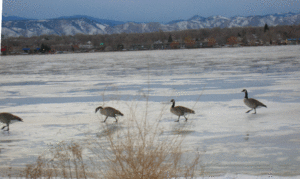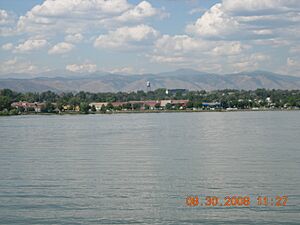Sloan Lake (Colorado) facts for kids
Quick facts for kids Sloan's Lake |
|
|---|---|

View facing east towards downtown Denver
|
|
| Location | Denver, Colorado, US |
| Coordinates | 39°44′56″N 105°02′51″W / 39.748876°N 105.047483°W |
| Basin countries | United States |
| Surface area | 177 acres (72 ha) |
| Surface elevation | 5,308 ft (1,618 m) |
| Settlements | Denver |
Sloan's Lake, also called Sloan Lake, is a large lake, park, and neighborhood in Denver, Colorado, USA. It's found on the northwest side of Denver. The lake is the main part of Sloan's Lake Park, which is looked after by the City and County of Denver's Parks and Recreation team.
Contents
About Sloan's Lake
Sloan's Lake is on the western edge of Denver. It is next to the towns of Lakewood, Edgewater, and Wheat Ridge. The lake's edges are roughly Sheridan Boulevard to the west, 17th Avenue to the south, Raleigh Street to the east, and 26th Avenue to the north. No streams flow into the lake.
How Sloan's Lake Was Formed

The exact story of how Sloan's Lake was created is not fully known. When people first settled the Denver area in the mid-1800s, the lake did not exist. A road called South Golden Road used to cross the area where the lake is now.
In 1866, a man named Thomas M. Sloan received land here from US President Andrew Johnson. Sloan planned to use the land for farming and raising cattle. A popular story says that Sloan dug a well, hit an underground aquifer (a layer of rock or soil that holds water), and woke up to find his farm flooded. This flood supposedly covered the old road, and the new road became Colfax Avenue.
However, an old stagecoach driver named Bill Turner said the lake appeared between 1861 and 1863. This was before Sloan officially owned the land. It's unlikely Sloan would have asked for land that was already underwater for farming.
The lake used to be bigger, covering over 200 acres (0.81 km2). It stretched further north and west. But parts of it were filled in over time.
Amusement Park History
The area around the lake once had an amusement park and swimming spot called Manhattan Beach. It opened in 1881 and was the first amusement park west of the Mississippi River. It burned down in 1908 and was rebuilt as Luna Park. However, due to problems and competition from other parks like Elitch Gardens and Lakeside Amusement Park, it closed in 1914.
In the 1930s, another nearby body of water called Cooper Lake was connected to Sloan's Lake. This was done by building channels under the water. This created one larger body of water, which is now known as Sloan's Lake. Today, the combined Sloan's Lake and Cooper Lake is 177 acres (0.72 km2).
Wildlife and Habitat
Sloan's Lake is home to many different birds, fish, and other animals throughout the year. You can see white pelicans, mallard ducks, Canada geese, and seagulls. Other birds like barn swallows, house finches, and common nighthawks also live here.
Cormorants and herons hide from animals on the shore by nesting on Cooper Island. They eat fish like black crappie, carp, and trout, which are put into the lake by the Colorado Parks and Wildlife agency. The shallow, muddy parts of the lake are good for wading birds like avocets. You might also see muskrats and nutria, which are semi-aquatic rodents. Foxes and coyotes are sometimes seen around the lake too.
Along the shoreline, you'll find cottonwood trees, cattails, and bluegrass. The lake waters have duckweed, algae, and other plants.
Sloan's Lake Park
Sloan's Lake Park is the second largest park in Denver, covering 177 acres (0.72 km2). Only City Park is bigger. People enjoy many activities here, such as hiking, jogging, and bicycling on the trails around the lake. Fishing and boating are also popular on the lake itself. The park has courts for basketball and tennis.
Every summer, the park hosts the Dragon Boat Festival. This event brings thousands of visitors and celebrates Asian American culture.
Sloan's Lake Neighborhood
The Sloan's Lake neighborhood has changed a lot recently. Many new homes and apartment buildings have been built. This has caused home prices to go up. For example, the average price for a single family home in 2017 was $543,400.
The homes in Sloan's Lake are varied. You can find old brick bungalows from the 1920s next to new, modern buildings. More than 66 percent of people living in Sloan's Lake own their homes.
A large hospital called St. Anthony's Hospital used to be south of the park. It closed, and now that area is being redeveloped. Plans include a 12-story condominium tower, a large apartment building, and many new restaurants and shops.
Images for kids





